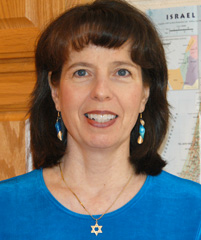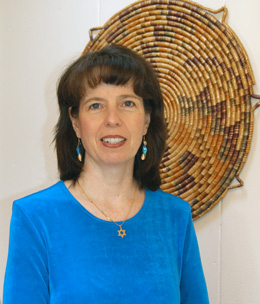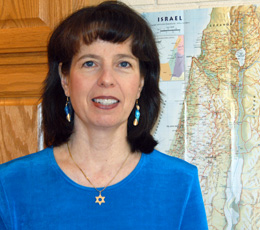Yom Hashoah adds liturgy to assure remembrance
Yom Hashoah is more than a remembrance of a historical event. For Mary Noble, it’s about life.
 |
| Mary Noble describes plans. |
As the daughter of Holocaust survivors, growing up in a community of Holocaust survivors in Toronto, Mary often heard those survivors saying, “Never again!”
Aware genocides keep happening, she believes it is crucial to remember, tell stories and create a faith commitment that will make “never again” a reality.
Jewish communities have been observing Yom Ha- Shoah since 1975.
For the 2006 Spokane Community Observance of the Holocaust, Mary has worked with Temple Beth Shalom to introduce the Shoah Scroll, a liturgy intended for annual use.
The observance of “Let There Be Light Again: Sixty Years after Nuremberg” will be held at 7 p.m., Tuesday, April 25, at Temple Beth Shalom, 1322 E. 30th Ave.
George Critchlow, associate professor at Gonzaga Law School and a founder and former director of the Gonzaga Institute for Action Against Hate, will be the featured speaker as part of the commemoration of the International Military Tribunal at Nuremberg.
There will also be music, reflections by survivors and a candle-lighting ceremony remembering the Holocaust, the murder of 6 million Jews in Eastern Europe and 5 million other people Nazis deemed unworthy of life.
“The liturgy is a service with the same words and components celebrated in many places,” said Mary, who believes that it is critical to institute something that will endure beyond the survivors’ lives.
The Rabbinical Assembly and Schechter Institute of Jewish Studies developed the liturgy in 2003.
“Jewish people have a memory of history thousands of years old and a tradition of commemorating that history,” she said.
 |
| Mary Noble shares family's story. |
Most Jews know about the Hebrews leaving slavery in Egypt through celebrating Pesah—the Passover—each year. They remember and relive the Exodus through rituals.
The Yom Hashoah liturgy was designed to create a similar fixed ritual to remind people what happened in the Shoah, when survivors are no longer alive to tell their personal stories.
The Shoah Scroll liturgy includes six three-minute readings of stories of people’s experiences in the Holocaust.
The readers will include Garry Oliver of Lincoln Heights Congregational Church; Dan Kleckner of KHQ, reading a journalist’s observation of life in the ghetto; Carla Peperzak, a survivor who worked with the Dutch underground in Holland, sharing the words of a woman, Gertrude, about life in the barracks, and Ron Klein, a psychologist, reading the account of a 25-year-old man who survived when he should have died with others.
Sam Schnall, rabbinic assistant at Temple Beth Shalom, will lead the responsive reading with the refrain, “For those do I weep,” to Eicha, the melody of Lamentations sung in Hebrew by Kimberly Bernhardt.
Joan Leeds, pastoral assistant at Our Lady of Fatima Catholic Church, just down the street from Temple Beth Shalom, will read the sixth reading, “Let There Be Light Again.”
Mary said that the liturgy moves people from the past, telling of survivors’ return to their homes, of their marriages, of the formation of Israel and of Jewish life flourishing.
“The generations that succeed the Holocaust survivors need a liturgy to keep remembering in a meaningful way,” she said. “We need to recount the atrocities, so we do not forget what humans have the potential to do to each other. I hope it moves more people to speak out about what is happening in Darfur and to prevent other Rwandas from happening.”
Mary remembers and keeps alive her parents’ stories.
That her parents had talked about their experiences was unusual. Many kept their stories secret. In Toronto, many of her parents’ friends were survivors. She overheard them talking about it when they came for coffee or to play cards.
“My parents told me stories when they tucked me in for bed,” she said. “Those stories became part of the fabric of my life.
Her mother, Shifra, grew up in Lelov, Poland. When she was 16, the war broke out. She was sent to a work camp in Czenstochov, where bullets were made for the Nazi war effort.
The people in the camp were carefully watched to prevent sabotage as they sorted and checked shells in inhuman conditions, Mary said. Her mother never knew if she would be there the next day, because each day, some were sent away and did not return.
“She did not dream of freedom or a future,” Mary said, “but kept alive by sharing memories of happier days.”
She was there with one of three sisters and two of four brothers.
On Jan. 16, 1945, Shifra’s brothers, Zalman and Machal, were selected and put on a train to Germany. As the train left, Germans ran out of the work camp. The Russian army was coming.
Grounds around the camp were mined. The prisoners feared that food was poisoned. People ran out of the camp in panic, afraid the Germans might come back and not knowing what to expect of the Russians.
“After years of starvation, deprivation, terror and humiliation, it was hard to know whom to fear and whom to welcome,” she said. “They did not know if the Russians would shoot them, rape them or treat them well. Eventually, they began to trust, as the Russians helped people find shelter and food.”
In January 1945 when Shifra was 21, she and her sister were the only survivors of a family of 10.
Mary’s father, Nechemia Knobel, who died three years ago in his early 90s, wrote journals on his family and war experiences.
“While some did not talk about or want to remember their experiences, he remembered dates and events,” she said.
Her grandfather had died in Bogria, Poland, when her father was 12, and his family moved to Lodz. In September 1939, when he was 30 and Nazis invaded Poland, he and his brothers headed to Warsaw. Polish men from 16 to 50 were ordered to go there to defend the country.
His writings tell of walking through fields because roads were bombed and full of corpses. The only light was from burning houses in Lovicz. They stayed in a barn in Grodzisk, in open fields or bushes, only to find that Nazis had already surrounded Warsaw.
Later in the war, he spent time in a prison camp, where he survived by using his tailoring skills to make coats for soldiers.
After returning to Lodz to find people at the end of the war, he became a Zionist organizer. While working in a fishing community near Hamburg, he met Shifra, who was caring for orphans. Both lived in a displaced persons camp. They married in 1947 and lived in Zeilsheim, a suburb of Frankfurt, where Mary’s brother was born.
Mary has visited places her parents lived in Germany and Israel, where they lived for two years and where her sister was born.
In 1952, two uncles in Toronto sponsored them to come to Canada, where she was born.
“Survivors in Canada valued family and community, aware they were a remnant,” she said, “but for years, few talked about their experiences or went to a synagogue.”
So in high school, Mary thought she was the only student whose parents were survivors.
She decided to become a doctor when she was young because she was fascinated with biology, physiology and “the wonder of how the human body works,” she said. “That’s an awe-inspiring religious experience for me.”
She relished learning how molecules and cells make muscles work for functions as simple as making an eye blink.
In addition, she is intrigued by how people deal with what happens in their lives and how that affects healing.
 |
| Mary Noble sees wider context of healing. |
For her, healing is in the context of respecting people. She knew experiences of her immigrant parents and their friends, navigating the medical system when they spoke little English.
So when Mary sees Russian-speaking patients, she is aware of language barriers—communicating through interpreters—and worldviews of different cultures.
“I try to envision my patients as people who could be my family and neighbors, not as strangers,” Mary said.
Her husband, Hershel Zellman, studied medicine at the University of California in Irvine. He came to Spokane for an externship at Deaconess in the summer of 1974, during Expo, and loved it.
After completing his residency in family practice at McMaster University in Hamilton, Ontario, where Mary studied, he came to Spokane to work with the Cooperative Health Plan. After her internship in Hamilton, she joined him, and they were married in 1979.
Sometimes her personal connection with the Holocaust makes Mary teary when talking about it. Their sons have made trips to Poland and visited concentration camps, but Mary has not.
However, she has connected with survivors of the genocide in Rwanda and is involved in the campaign to educate people about the atrocities in Darfur.
“It’s terrible that as humanity we have not learned. Although I grew up saying, ‘never again,’ it keeps happening. Governments stand by. It’s not politically expedient to intervene. As individuals, we do not feel we have power. We feel bad about it but go on with what we are doing. Few are activists.
“We hope that by participating in the Holocaust commemoration, our community will be moved to confront genocide and injustice anywhere it may occur,” Mary said.
For information, call 747-3304.
Copyright © April 2006 - The Fig Tree




